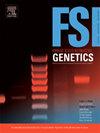汉人107 plex STR位点和292 plex SNP位点的法医组合面板的大规模平行测序
IF 3.1
2区 医学
Q2 GENETICS & HEREDITY
引用次数: 0
摘要
大规模平行测序(MPS)是一种完善的法医DNA分析策略,能够以高覆盖率的单碱基分辨率同时对多个样品的多个靶向位点进行测序。在这项研究中,我们将基于溶液的杂交捕获方法与MPS相结合,开发了一种新的分型系统,针对汉族人群中多达107个短串联重复序列(STRs)和292个单核苷酸多态性(SNPs)。与常规毛细管电泳分型结果相比,STR基因型完全准确一致,有6个位点由于等位基因缺失甚至位点缺失而表现不佳。当DNA输入为10 ng时,STRs的位点检测成功率为85.2% %,当DNA输入为5 ng时,SNPs的位点检测成功率为95.61 %。混合研究证实了我们的系统在STR和SNP位点上识别次要贡献等位基因的巨大潜力。此外,该系统在区分一级亲缘关系和不相关的个体对方面表现出充分的推理能力,在识别二级和三级亲缘关系方面分别取得了99.78 %和80.2 %的显著效率。这些结果表明,我们的新型分型系统在汉族人群中具有高度的判别性和信息性,在亲子鉴定和复杂亲属关系分析中具有很高的效率。本文章由计算机程序翻译,如有差异,请以英文原文为准。
Massively parallel sequencing of a forensic combined panel of 107-plex STR loci and 292-plex SNP loci in the Han Chinese population
Massively parallel sequencing (MPS), a well-established strategy for forensic DNA profiling, enables the simultaneous sequencing of multiple targeted loci of multiple samples at a single-base resolution with high coverage. In this study, we developed a novel typing system by combining solution-based hybrid capture methods with MPS to target as many as 107 short tandem repeats (STRs) and 292 single nucleotide polymorphisms (SNPs) in the Han Chinese population. Completely accurate and concordant STR genotypes were obtained when compared to typing results generated from conventional capillary electrophoresis analysis, with six loci exhibiting inferior performance due to allele dropout or even locus dropout. The locus detection success reached 85.2 % for STRs at a DNA input of 10 ng and 95.61 % for SNPs at a DNA input of 5 ng. Mixture studies substantiated the considerable potential of our system in identifying minor contributor alleles at both STR and SNP loci. Additionally, the system demonstrated full inferential abilities in distinguishing first-degree kinship from unrelated individual pairs and achieved significant effectiveness of 99.78 % and 80.2 % for the identification of second- and third-degree kinship, respectively. These findings indicated that our novel typing system is highly discriminative and informative when used in the Han Chinese population and would be highly efficient for use in paternity testing and complex kinship analysis.
求助全文
通过发布文献求助,成功后即可免费获取论文全文。
去求助
来源期刊
CiteScore
7.50
自引率
32.30%
发文量
132
审稿时长
11.3 weeks
期刊介绍:
Forensic Science International: Genetics is the premier journal in the field of Forensic Genetics. This branch of Forensic Science can be defined as the application of genetics to human and non-human material (in the sense of a science with the purpose of studying inherited characteristics for the analysis of inter- and intra-specific variations in populations) for the resolution of legal conflicts.
The scope of the journal includes:
Forensic applications of human polymorphism.
Testing of paternity and other family relationships, immigration cases, typing of biological stains and tissues from criminal casework, identification of human remains by DNA testing methodologies.
Description of human polymorphisms of forensic interest, with special interest in DNA polymorphisms.
Autosomal DNA polymorphisms, mini- and microsatellites (or short tandem repeats, STRs), single nucleotide polymorphisms (SNPs), X and Y chromosome polymorphisms, mtDNA polymorphisms, and any other type of DNA variation with potential forensic applications.
Non-human DNA polymorphisms for crime scene investigation.
Population genetics of human polymorphisms of forensic interest.
Population data, especially from DNA polymorphisms of interest for the solution of forensic problems.
DNA typing methodologies and strategies.
Biostatistical methods in forensic genetics.
Evaluation of DNA evidence in forensic problems (such as paternity or immigration cases, criminal casework, identification), classical and new statistical approaches.
Standards in forensic genetics.
Recommendations of regulatory bodies concerning methods, markers, interpretation or strategies or proposals for procedural or technical standards.
Quality control.
Quality control and quality assurance strategies, proficiency testing for DNA typing methodologies.
Criminal DNA databases.
Technical, legal and statistical issues.
General ethical and legal issues related to forensic genetics.

 求助内容:
求助内容: 应助结果提醒方式:
应助结果提醒方式:


